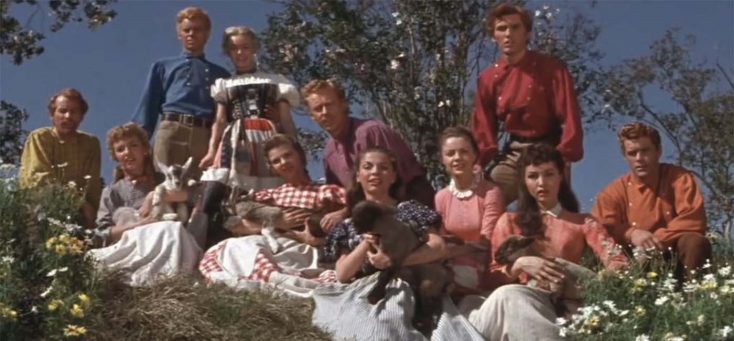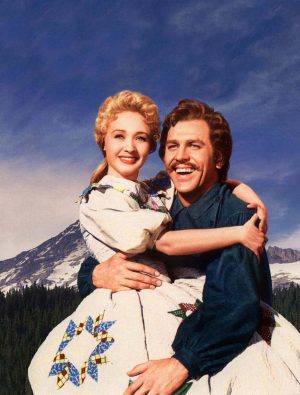By JUDY SLOANE
Front Row Features
The early 1950s found MGM Studios spending lavish amounts of money on such musical classics as “Annie Get Your Gun” and “Kiss Me Kate.” But in 1954 it was the low-budget, innovative production of “Seven Brides for Seven Brothers” that won both the critics’ and the public’s heart, becoming one of the most popular films of the year.
Set in Oregon in the 1850s, the story follows the escapades of the seven Pontipee brothers, backwoodsmen who set out to find themselves wives. Starring Howard Keel Adam Pontipee and Jane Powell as Milly, who marries Adam unaware that there are six brothers-in-law she will also be taking care of.
The picture’s extraordinary, athletic dance routines by Michael Kidd became film history, and in 1997 he won an honorary Academy Award in recognition of his services to the art of dance on screen. In 1955, “Seven Brides for Seven Brothers” was nominated for an Oscar for Best Picture, but lost to “On the Waterfront.”
In 1994, I spoke with the movie’s director, Stanley Donen (“Singing in the Rain,” “On the Town”), and stars Howard Keel, Jane Powell, dancer Tommy Rall (who played Frank), Russ Tamblyn (who portrayed Gideon) and actress Julie Newmar (who played Dorcas and whose name was Julie Newmeyer at the time.) Unfortunately, everyone has passed on except for Russ Tamblyn and Julie Newmar.
Judy Sloane: Howard, what was it like being surrounded by dancers instead of actors?
Howard Keel: They were all very good. Generally dancers are pretty good actors. They all got along great
Judy Sloane: Jane, why was the budget for the movie so low?
Jane Powell: The movie was supposed to be a bigger budget picture. MGM didn’t really want to do it. Jack Cummings, the producer, wanted to do it so badly that they said, “Okay, you can do it, but they cut the budget in half because they were putting all their money into “Brigadoon.” “Seven Brides” became a sleeper and went on to Radio City Music Hall. They made more money on “Seven Brides” than they did on “Brigadoon,” and spent half the money!
Judy Sloane: What was it like portraying Milly?
Jane Powell: Milly had much more character than any part I had ever played, so it was wonderful.
Howard Keel: Jane’s a real pro. She can dance, she can sing and she can act. I think the chemistry between us was absolutely right.
Judy Sloane: Stanley, what was the biggest problem you had when you first agreed to direct the movie?
Stanley Donen: MGM didn’t want to use a new score. They wanted folk songs from the west and nobody dancing! The whole thing was a struggle. I wanted Michael Kidd for the picture, but it took me weeks to persuade him to come aboard. I had to talk him into it. I just was certain that he was the man for the movie. I persisted, and eventually he gave in.
Russ Tamblyn: Michael wanted six great dancers, the seventh being Howard Keel. The studio finally said, ‘Well, we have actors under contract here, so what we decided to do is that you can have four great dancers (Tommy Rall, Marc Platt, Matt Mattox and Jacques d’Amboise) and two actors.” The two actors were myself and Jeff Richards.
Judy Sloane: Do you remember the first time you met Michael Kidd?
Russ Tamblyn: They had already started rehearsals and Jeff and I came to watch them, just to chum around with the other brothers. Michael Kidd came up to me and said, “Somebody told me you’re an acrobat, that you’ve done a lot of gymnastics.” I said, “Oh yeah,” and I did a backflip for him on the spot. He said, “That’s fantastic, we’ll put it in the numbers!”
Judy Sloane: How hard was it for Jeff, not being a dancer?
Russ Tamblyn: Jeff Richards didn’t want to be in it. If you remember, we were all prancing around in the countryside singing, “Oh the barnyard is busy in a regular tizzy, and the obvious reason is because of the season.” All walking around picking flowers – he hated that. This was a rough and tumble baseball guy.
Howard Keel: Jeff Richards was a tough kid; he wound up being a bouncer in a bar. There was always a kind of competition about whether he could lick me or not. That came across in the film, I think.
Judy Sloane: Julie, you were Jeff’s dance partner in the film, what was that like?
Julie Newmar: Jeff was the only one who didn’t dance. I was a fast and furious dancer, and felt most capable of this rambunctious style of dancing which Michael Kidd gave mainly to the boys! The girls had to be delicate, demure and definitely pure.
Judy Sloane: Howard, is there anything in the movie that was left out that you were disappointed about?
Howard Keel: I had one song taken out because it was like the Soliloquy from “Carousel.” It was to take place when I was up in the mountains. I never did record it. Actually, I pulled our producer Jack Cummings aside and said, “I just think it’s wrong” – I might have been wrong myself!
Judy Sloane: Was there any competition between the brothers?
Tommy Rall: With me there’s always a sense of competition, especially if there’s another dancer. I guess that’s just bred in me from my early days when I was a very young performer in vaudeville. But I think it was good humored competitions to see who could do what, who could do more pirouettes, who could jump higher.
Russ Tamblyn: There were times where we would all go out to lunch together. We all had our hair dyed flaming red, and I remember the seven of us getting into Howard Keel’s convertible with the top down, and we went to a drive-in. Everybody was staring at us. We must have looked crazy, all these seven red-headed, long-haired guys in this Cadillac, sitting there laughing. We were having a grand time, and these women were staring at me, and I heard one of them say, “Isn’t that strange, those six guys with one girl!”
Judy Sloane: I hear the number Goin’ Courtin’ was hard to do.
Russ Tamblyn: The dancers had a hard time looking clumsy, like they didn’t know how to dance. You can imagine when there is music playing and they say, “But don’t dance, look like you’re just learning it.” It was impossible. So finally, Michael put me out in front because I was the one that could just jump around like I was having a good time and not look like I was a good dancer.
Judy Sloane: Stanley, for you what was the most difficult aspect of filming the movie?
Stanley Donen: Continually having so many characters on the screen at the same time. It was very difficult. You have fourteen people to cope with. If you get twelve of them doing what you want, and two aren’t, the question is how long do you go at it, and will the others get obstreperous.
Judy Sloane: The barn dance in the movie became one of the most iconic numbers ever filmed – what do you remember about it?
Julie Newmar: When you see it up on the screen, it doesn’t have that sense of fear. Is Tommy Rall going to fall off those two planks that he’s about to do a backflip on? Are they going to fall without breaking their ankles? Somehow the camera tries to catch it, but it was only when you were there in person that you had the awesome experience of watching it happen.
Tommy Rall: It was hard physically and if you missed you were going to break an ankle. But I think everybody enjoyed it, and maybe that projected itself into the number.
Julie Newmar: Tommy Rall was one of the greatest dancers in the world. He could do sixteen pirouettes on one foot, and do it over and over without stopping.
Russ Tamblyn: I don’t think I’ve done anything that took as many takes as jumping back and forth over the axe. It took about thirty takes to finally get it. That was probably one of the hardest things that I ever did.
Judy Sloane: I heard a special visitor came to see the barn dance.
Russ Tamblyn: When we finally finished the number, the very first person that came on the set was Gene Kelly. He had been friends with Stanley Donen for a long time, so Stanley had Gene come over, and the whole cast did the number just for him. I remember his line when we finished the dance and we were all puffed out and tired. Gene Kelly looked at all of us and said, “Well, you guys, all I can tell you is there’s nothing left for you to do but cut yourselves and bleed!” I remember that as clear as a bell.
Portions of this article were first published in Film Review Magazine






